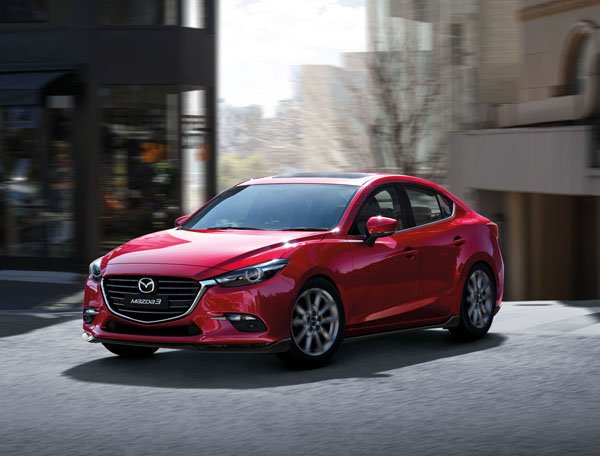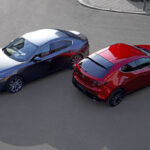
When you’re on to a good thing . . . no need to tell Mazda that, the company, line with its Kodo – soul of motion – philosophy in which colour is a prime element of form, has splashed out on a new exotic exterior colour for its popular Mazda3.
This follows the success of Soul Red Crystal in the top-selling CX-5 SUV. Since its debut, the colour has proven a fast favourite with customers, with around 22 per cent of CX-5s sold being in colour.
Unfortunately, our test vehicle, a Mazda3 Maxx hatchback, was blue, so lacked some of the ‘soul’ imparted by the new hue. Not to worry. The mid-range model at $24,890, plus on-road costs, had much to offer.
The Mazda3 range covers six models, all in hatchback and sedan, with two petrol engines, plus six-speed manual or automatic transmission.
STYLING
In a congested car market it takes more than keen pricing to climb above the crowd. Nobody knows this better than Mazda, so ignoring the above, the design of the latest Mazda3 is hardly soulless.
A new front grille adds a touch of aggression. Mazda tells us the lower positioning of the Mazda badge and number plate holder hint at a lower centre of gravity. So there.
There’s a newly-designed rear bumper stands for stability.
INTERIOR
Quite rightly, the driver remains the main focus of the cabin, although other occupants are not treated as second-class passengers. Meters have been simplified, a new steering wheel added and USB inputs have been moved to the centre console.
The hatchback can take 308 litres in the rear cargo area, while the sedan’s boot capacity comes in at 408 litres.
INFOTAINMENT
Mazda3 Maxx incorporates MZD Connect which puts cabin occupants in touch with the internet and provides access to social networking services.
Control is via a 7-inch full colour touchscreen on the central dashboard and multi-function command controller, a knob on the centre console surrounded by related function switches.
It offers Bluetooth hands-free phone operation, reception of short text messages, and internet radio such as Aha with access more than 100,000 broadcasts from around the world, even including the likes of BBC and CNN.
Also featured are DAB+ digital radio, Radio Data System program information and satellite navigation. The screen also displays the reversing camera signal.
ENGINES / TRANSMISSIONS
The 2.0-litre petrol engine with 114 kW of power and 200 Nm of torque is available on Neo, Maxx and Touring grades. The more powerful 2.5-litre petrol engine, with 138 kW of power and 250 Nm of torque, comes standard on SP25, GT and Astina variants.
The 2.2-litre-D diesel no longer appears in the picture as sales were minimal.
SAFETY
New safety technology; including smart city brake support-forward is now standard across the range, while Mazda3 Maxx and all grades above get SCBS-Reverse, blind spot monitoring and rear cross traffic alert.
DRIVING
Maximum power of 114 kW from the 2.0-litre motor turns up late in the rev range, at 6000 rpm, so the Mazda3 Maxx is in no hurry to get off the mark. In fact, with the pedals symmetrically placed to the left and right of the driver’s centre line, and a hinged organ-type accelerator, driving is altogether an unhurried rather relaxed experience.
The drive can be spiced up by means of the Skyactiv-Drive transmission, which enables the driver to move into Sport mode using the switch on the shift gate. This alters the engine characteristics, shift timing and shift speed to provide stronger acceleration at the touch of the pedal.
Well positioned A-pillars and side mirrors mounted on the doors give good visibility for the driver.
Occupants also experience a quieter drive thanks to better noise, vibration and harshness measures.
The new Mazda3 also offers improved handling and ride comfort, thanks to G-Vectoring Control that improves chassis balance by adjusting engine torque in response to steering inputs in a unified manner and optimise the vertical loading of each tyre to give smooth and efficient vehicle behaviour – plus electric power assist steering, damper and suspension enhancements.
Fuel consumption of the 2.0-litre six-speed automatic hatchback on the combined urban / highway cycle is a claimed 5.8 litres per 100 kilometres. The test car came up with 9.7 litres per 100 kilometres in town and 4.5 on the highway.
Fuel economy is aided by Mazda’s idling stop / start engine system. When the driver presses the brake pedal and comes to a stop, the system automatically stops the engine. On releasing the brake or engaging the clutch to move off, fuel is injected directly into the cylinder and the engine automatically fired up.
SUMMING UP
‘Spoilt for choice’ could be the mantra of the Mazda3. The Maxx is well specced for the price, so it’s a matter of sitting down and working out the value for money. Alternatively, just pick the one you like the look of.
AT A GLANCE
MODEL RANGE (hatch and sedan)
Mazda3 Neo: $20,490 (manual), $22,490 (automatic)
Mazda3 Maxx: $22,890 (manual), $24,890 (automatic)
Mazda3 Touring: $25,290 (manual), $27,290 (automatic)
Mazda3 SP25: $25,690 (manual), $27,690 (automatic)
Mazda3 SP25 GT: $29,990 (manual), $31,990 (automatic)
Mazda3 SP25 Astina: $33,490 (manual), $35,490 (automatic)
Note: These prices do not include government or dealer delivery charges. Contact your local Mazda dealer for drive-away prices.
SPECIFICATIONS (Mazda3 Maxx 2.0-litre petrol 6sp Skyactiv-Drive auto hatchback)
ENGINE:
Capacity: 1.988 litres
Configuration: Four cylinders in line
Maximum Power: 114 kW @ 6000 rpm
Maximum Torque: 200 Nm @ 4000 rpm
Fuel Type: Petrol 91RON
Combined Fuel Cycle (ADR 81/02): 5.8 L/100km
CO2 Emissions: Euro V
DRIVELINE: Six-speed Skyactiv-Drive automatic
DIMENSIONS, WEIGHT AND CAPACITIES:
Length: 4470 mm
Wheelbase: 2700 mm
Width: 1795 mm
Height: 1450 mm
Turning Circle: 10.6 metres
Kerb Mass: 1296 kg
Fuel Tank Capacity: 51 litres
BRAKES:
Front: Ventilated disc
Rear: Solid disc
STANDARD WARRANTY:
Three years / unlimited kilometres










